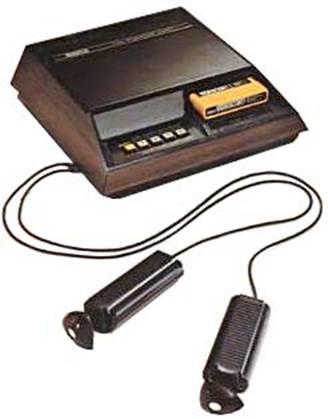Fairchild Video Entertainment System (Channel F)
Fairchild Camera and Instrument release date 1976.
Cost of System at release: $170.00
Processing Speed: 2 Mghtz
RAM: 64 bytes
Color capacity: 8
Sound: internal to the game system
Dubbed as the first programmable* cartridge based video game system to be introduced into the consumer market, the Fairchild Video Entertainment System set the stage for the future of video gaming. The Fairchild VES came out in 1976 due to the need to expand the variety of game play without the need to buy each individual game console. At the time, the PONG gaming systems were bountiful and flourishing. The general public had only so much space to warehouse their videogame systems and for a practical matter, it made financial sense to be able to adapt the game console with a programmable cartridge. This allowed the consumer to not be forced to invest in a dedicated system. Swapping games within a console was a very innovative idea. This idea was initially brought forth with the Magnavox Odyssey system, which was released approximately four year prior to the launch of the Channel F. The difference between the cartridge based Channel F and the interchangeable circuit board Magnavox Odyssey system confuses people. I still get email from people telling me that the Odyssey was the first cartridge based system. Yes, it would be considered the first true cartridge based system, but not the first programmable cartridge system. The Magnavox Odyssey systems interchangeable cartridges acted as circuit boards within the architecture of the console and did not use any ROM or any code through a microprocessor. It eliminated the need to tape on screen overlay like the Odyssey system as well and was in COLOR.
Fairchild Camera and Instrument took advantage of the newly emerging computer game industry with their unique Fairchild Video Entertainment System. The system itself comes in different versions. It was released and re-released and licensed in many different countries under different names. Needless to say it floundered in the market place in about a year’s time. It never really did well in competition with the Atari VCS and Mattel Intellivision. This was largely due to the lack of software support and diversity of the games. This disappointing performance occurred despite the fact the system was released approximately one year prior to the release of the Atari system. The Fairchild Video Entertainment Systems cartridges are also unique in that the cartridges are numbered. There are approximately 30 cartridges available for this gaming system when taken into account the foreign releases. Some are quite common but others are quite rare, especially the foreign releases.
The system should be credited for a few innovative features, most notably the ability to pause the game during a match. This simple but effective task was first originated by this system. Also the operator could adjust the total amount of time that the game will play and did I mention the fact that it was the first programmable cartridge based system. This in itself provides a good reason to purchase a Fairchild F game system if one wants to be a collector.
The games are nothing to write home about, it is very obscure, but in the context of its time they were quite remarkable. The games consist of sports games, action games and educational games. The carts resemble an 8-track tape, if you’re old enough to remember this storage media. It possesses a unique joystick that lacks the precision of the present day joysticks. It resembles a narrow hand grenade with a triangular head. It has the capacity for 8- direction movement and the triangular handle could be twisted like a paddle system. The triangular head could also be depressed and lifted, which functioned as the fire button. There are many downsides to this controller. The wires tend to break/fracture within the wiring thus making the system obsolete due to the fact that the controller is hard wired into the system. The later systems corrected this problem with removable controllers. Another downside in the earlier systems was that the sound originated from the gaming system and not the television. The sound effects are horrible. This probably is one of the reasons for the demise of this system. The sound was also improved on in the later models by having the sound originate from the television, but this did not salvage this sinking ship. This system disappeared approximately in 1979 directly due to the competitions of the other alternative systems available at the time. From my understanding it did fairly well outside of the United States, most notably in Europe. In fact I own 2 German Saba Videoplay systems. I also own one of the Holy Grail cartridges for this system (Its number 20 (Schach), which is the Chess cartridge). It was only released in Germany and you cannot find it very easily these days. If you see it, buy it because it’s highly sought after.
This system is still quite available from many collectors and from the original owners who have stored their old systems for nostalgia reasons.
FAIRCHILD CHANNEL F SYSTEMS:
- Fairchild Video Entertainment System -1976
- Fairchild Channel F System II- 1982
- Saba Videoplay 1/ Saba Videoplay 2- (Germany) -1982
- ITT Telematch Processor - 1982
- Luxor Video Entertainment system (Sweden)
- Grandstand Video Entertainment Center – (Great Britain) 1978

